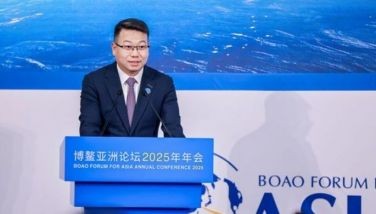Scout’s honor
October 23, 2006 | 12:00am
In this corner a few days ago, I made the sarcastic remark that while wearing his unbuttoned Marine "colonel" uniform over a red shirt, Makati Mayor Jejomar Binay – being a few inches shorter than Napoleon Bonaparte, I might add – looked more like a Boy Scout, but "he’s no Boy Scout."
An alert reader, Mr. Jonathan Ibañez of Davao Oriental, took this flippant sentence seriously, and correctly texted INBOX (Oct. 21 issue) to say: "To Manong Max: Binay is a Boy Scout. He is the current National President of the Boy Scouts of the Philippines."
Thanks, Jonathan; by official title, indeed, that’s what Jojo is.
Yet, what makes a Boy Scout? In this country, politicians in particular get conferred titles or get "elected" to positions like "president" or "chairman" of this and that. A former Boy Scout myself, I was years ago a member of the Boy Scout National Committee. However, what’s important is not how one sports the uniform, but how a Scout lives up to his organization’s creed.
Lord Baden-Powell, it’s well-established founded the Boy Scouts as an institution to make boys into men, instill in them with the ideals of good citizenship, and ultimately (this is relatively unknown) prepare them for military service if a call to battle was ever made.
Remember the Scout creed? To mention a few of a Scout’s qualities: A Scout is "honest." A Scout is "reverent." A Scout is "helpful" . . . and so forth. Who, grown to adulthood, measures up to these? Yet, that’s the measure of a Boy Scout.
When we were kids in grade school, in the Ateneo and in Paco Catholic School, most of us were enrolled in the Boy Scouts. We learned self-reliance, lighting fires without matches or lighters, "tracking" in the forest, knot-tying – sometimes we tied ourselves up in knots – and all the survival skills. What was vital in every Scout, we were taught, was the drive for excellence.
In those days, our handbook was still designed for "The Boy Scouts of America." Thus we strove to qualify from Tenderfoot, to Third Class, Second Class, and then First Class Scout. The supreme challenge was to become an Eagle Scout, wearing the coveted sash stitched in with badges of honor for every achievement.
In these cynical times, I confess, I long for the good old days of innocence and striving – to climb every mountain (corny as it sounds), to reach for the stars.
Is Jojo Binay a Boy Scout? Are any of us still Boy Scouts? Or have we lost the trail?
Another great institution – whatever brickbats have been hurled at it, and having seen certain alumni exposed for having failed the test of Courage, Integrity, Loyalty – is the Philippine Military Academy which celebrated its 108th Foundation Day last Saturday at Fort del Pilar in Baguio City.
The PMA was officially created, of course, by the National Defense Act of 1935, as signed into law by President Manuel L. Quezon, and empowered to confer the degree of Bachelor of Science on its graduates.
By a stretch, it really traces its origin to the Academia Militar, an officers’ school founded by General Emilio Aguinaldo, the Philippine Revolutionary President, in October 1898, in Malolos, Bulacan. The school broke up its studies and within a year went into practicum with its students forming the officer corps of the battalions we sent into combat in the Philippine-American War.
In his interesting little volume, "PMA Turning the Corner," Maj. Gen. Rufo A. de Veyra, the 48th PMA Superintendent, recounts that Douglas MacArthur, "a 1903 graduate of the US Military Academy in West Point, had his baptism of fire in the island of Samar… killing two Filipinos."
Like the Spaniards before them, having observed how tough the Filipinos had been in fighting them, the Americans began recruiting "indigenous" troops to help "pacify the islands." They set up a Philippine Constabulary school in 1905 in Intramuros, the Walled City of Manila, which supplied the officers to lead the law enforcement phalanx of the colonial regime. Later, the Constabulary school was transferred to Baguio, the "summer capital" of the time.
The PC were such an effective unit that when my late father, who was then Chairman of the National Defense Committee of the National Assembly went to Mindanao in 1940 to inspect "law and order" there, he found everything relatively tranquil from Davao to Zamboanga City. He had gone there by ship, the MV "Corregidor", which was at the time touted as the fastest passenger vessel plying the seas between Luzon, Visayas and Mindanao. (Sad to say, that much-admired vessel met a tragic end. When the Japanese attacked Pearl Harbor on December 7 (December 8th, our time) 1941, the "Corregidor", packed to the rafters with prominent people trying to flee to their home provinces in the south, hit a mine just outside Manila Bay and sank, bringing most of its passengers, whether rich or poor, to a watery grave).
However, dad managed his tour of Mindanao without incident, returning to Manila aboard, I think, a less splendid but still efficient Compania Maritima vessel. Congressmen today who fly to and fro by PAL, don’t realize they have it easy.
The visit which most impressed my father was the stopover at the Philippine Constabulary camp on Lake Dansalan (Marawi). There, he learned that 200 PC was all it took to maintain order throughout Mindanao. Remember the old Constabulary motto: "Always Outnumbered, Never Outfought."
There’s an old movie, starring Gary Cooper, which hymned the valor and steadfastness of the PC and, naturally, its American officers, in the pre-war days in which Moro "pirates" or attackers were the so-called "bad guys." (These days it’s "politically incorrect" to profile the Moros). Anyway, that stirring black-and-white motion picture was titled, "The Real Glory."
The Gary Cooper film introduced worldwide audiences, I must say, to the concept of the "Juramentado" or Muslim Amok – the forerunners two centuries ago of today’s suicide-bombers and Martyr Mujahideen.
In those centuries past, the Muslim Warriors didn’t have bombs, but they used their sharp swords, the kris or the kampilan to deadly advantage. Many times in "Spanish" cities like Zamboanga, the warning cry would go up: "Juramentao, Juramentao!" as a kris-wielding Moro would rampage through the town, cutting down Christians right and left until felled by police or Constabulary rifles.
In his jewel of a book, "Zamboanga Hermosa." (Beautiful Zamboanga) our old friend Tony Orendain II, explained it dramatically. He pointed out that the dreaded name, Juramentado" or Juramentao was derived from the Spanish word "Juramentar" or to take an oath. The term was institutionalized during the Spanish campaign in Sulu in 1876, to refer to the Tausug braves who swore to throw back the "invaders" by personal action when organized resistance failed.
It was actually a Muslim religious rite in which "killing as many Christians as possible and expecting to be killed in return" was a guarantee of a swift trip to heaven. Orendain called it "a degenerative form of the holy duty, called jihad, to defend dar-ul-Islam (name of Islam) from unbelievers and infidels, with a pledge of Paradise as a reward.
"Thus, before a mujanid (Juramentado) could set out to perform his duty, he had to inform his sultan or datu of his intentions …" Orendain remarked.
The elaborate ritual required the mujanid to perform the following: "He bathes himself clean of impurities, shaves himself bald, including his eyebrows, and spends the whole night with a pandita (priest) who recites to him passages from the Qu’ran. He dresses himself in white and wears a white turban in which attire he shall be buried and ride a white horse to heaven." There was no mention by Tony of the Virgins supposed to a waiting the martyr in paradise.
Lawyer Journalist Orendain produced his book in 1984, decades before a deluge of volumes and reams of copy emerged about Islam, the alleged "clash of civilizations" and the idea of martyrdom by suicide-bomb attack.
The most famous American to come out of Mindanao was, indubitably, General John J. "Black Jack" Pershing. Then a Captain, Pershing was stationed in Zamboanga for four years, serving as Governor of the Moro Province.The Americans had designated Zamboanga City as the capital.
He is best remembered for his having asked the US government to get him and his men a pistol which could known a man down with the first bullet, in order to stop a Juramentado in his tracks. He had noted that a Moro amok, although shot several times could still stagger on, cutting down people, until he succumbed to his wounds. To oblige, Browning produced the .45 caliber pistol.
Pershing, who established Pasonanca Park and "Plaza Pershing", the public square that now bears his name in Xambo, went back to the US to pursue the Mexican bandit (the Mexican "hero", for their side of course), Pancho Villa and his El Dorados.
Pershing achieved fame by being named head of the American Expeditionary Force to Europe when American entered World War I. Thus a "Zamboangeño", the people there now quip, made it the world stage.
There’s a beautiful story, I hope it’s not apocryphal, about Pershing who arrived in France. US History relates how a dashing young French aristocrat, the Marquis de Lafayette had joined George Washington and the Continental Army to fight to overthrow British rule during the American Revolution. Lafayette had, ultimately, helped convince the French King to send troops and warships to assist the American colonists in defeating the British and their Hessian mercenaries – for France’s own interests, it must be noted, as well as her support of liberty.
When Persing got to France, he sought out the grave of the renowned Frenchman who had rallied to their cause. Laying a wreath at his tomb, Persing had declared, emotionally: "Lafayette, we are here!"
May such stories never fade.
Three years ago, when President GMA made her state visit to Washington DC, I flew to New York separately and there saw once more the great Statue of Liberty in New York harbor which had been donated in Friendship by the people of France.
Then I took a train to Washington’s Union Station, so I could join the official party for the State dinner in the White House. The morning of that day, we had breakfast in the Blair House, which is the official guest house for visiting heads of state and other VIPs.
The period marked the height of the animosity between Washington and Paris, owing to President Jacques Chirac’s scornful rejection of President Bush’s plan to invade Iraq. US congressman had even demanded that "French fries" be eliminated from the Congressional and all official menus, and renamed "Freedom Fries," remember?
On leaving the Blair House for the parade on the White House lawn I noticed a portrait hanging on the wall beside the entrance of the residence. I had spotted who it was from old prints, but I checked with the US Marine guard by the door. "Why sir," he replied, "it’s Lafayette."
My reaction must have puzzled the Marine. I said, "That’s a sign, that America and France, whatever their bitter disputes, will always remain friends."
Call me stupid, but that’s what I think.
An alert reader, Mr. Jonathan Ibañez of Davao Oriental, took this flippant sentence seriously, and correctly texted INBOX (Oct. 21 issue) to say: "To Manong Max: Binay is a Boy Scout. He is the current National President of the Boy Scouts of the Philippines."

Thanks, Jonathan; by official title, indeed, that’s what Jojo is.
Yet, what makes a Boy Scout? In this country, politicians in particular get conferred titles or get "elected" to positions like "president" or "chairman" of this and that. A former Boy Scout myself, I was years ago a member of the Boy Scout National Committee. However, what’s important is not how one sports the uniform, but how a Scout lives up to his organization’s creed.
Lord Baden-Powell, it’s well-established founded the Boy Scouts as an institution to make boys into men, instill in them with the ideals of good citizenship, and ultimately (this is relatively unknown) prepare them for military service if a call to battle was ever made.
Remember the Scout creed? To mention a few of a Scout’s qualities: A Scout is "honest." A Scout is "reverent." A Scout is "helpful" . . . and so forth. Who, grown to adulthood, measures up to these? Yet, that’s the measure of a Boy Scout.
When we were kids in grade school, in the Ateneo and in Paco Catholic School, most of us were enrolled in the Boy Scouts. We learned self-reliance, lighting fires without matches or lighters, "tracking" in the forest, knot-tying – sometimes we tied ourselves up in knots – and all the survival skills. What was vital in every Scout, we were taught, was the drive for excellence.
In those days, our handbook was still designed for "The Boy Scouts of America." Thus we strove to qualify from Tenderfoot, to Third Class, Second Class, and then First Class Scout. The supreme challenge was to become an Eagle Scout, wearing the coveted sash stitched in with badges of honor for every achievement.
In these cynical times, I confess, I long for the good old days of innocence and striving – to climb every mountain (corny as it sounds), to reach for the stars.
Is Jojo Binay a Boy Scout? Are any of us still Boy Scouts? Or have we lost the trail?
The PMA was officially created, of course, by the National Defense Act of 1935, as signed into law by President Manuel L. Quezon, and empowered to confer the degree of Bachelor of Science on its graduates.
By a stretch, it really traces its origin to the Academia Militar, an officers’ school founded by General Emilio Aguinaldo, the Philippine Revolutionary President, in October 1898, in Malolos, Bulacan. The school broke up its studies and within a year went into practicum with its students forming the officer corps of the battalions we sent into combat in the Philippine-American War.
In his interesting little volume, "PMA Turning the Corner," Maj. Gen. Rufo A. de Veyra, the 48th PMA Superintendent, recounts that Douglas MacArthur, "a 1903 graduate of the US Military Academy in West Point, had his baptism of fire in the island of Samar… killing two Filipinos."
Like the Spaniards before them, having observed how tough the Filipinos had been in fighting them, the Americans began recruiting "indigenous" troops to help "pacify the islands." They set up a Philippine Constabulary school in 1905 in Intramuros, the Walled City of Manila, which supplied the officers to lead the law enforcement phalanx of the colonial regime. Later, the Constabulary school was transferred to Baguio, the "summer capital" of the time.
The PC were such an effective unit that when my late father, who was then Chairman of the National Defense Committee of the National Assembly went to Mindanao in 1940 to inspect "law and order" there, he found everything relatively tranquil from Davao to Zamboanga City. He had gone there by ship, the MV "Corregidor", which was at the time touted as the fastest passenger vessel plying the seas between Luzon, Visayas and Mindanao. (Sad to say, that much-admired vessel met a tragic end. When the Japanese attacked Pearl Harbor on December 7 (December 8th, our time) 1941, the "Corregidor", packed to the rafters with prominent people trying to flee to their home provinces in the south, hit a mine just outside Manila Bay and sank, bringing most of its passengers, whether rich or poor, to a watery grave).
However, dad managed his tour of Mindanao without incident, returning to Manila aboard, I think, a less splendid but still efficient Compania Maritima vessel. Congressmen today who fly to and fro by PAL, don’t realize they have it easy.
The visit which most impressed my father was the stopover at the Philippine Constabulary camp on Lake Dansalan (Marawi). There, he learned that 200 PC was all it took to maintain order throughout Mindanao. Remember the old Constabulary motto: "Always Outnumbered, Never Outfought."
There’s an old movie, starring Gary Cooper, which hymned the valor and steadfastness of the PC and, naturally, its American officers, in the pre-war days in which Moro "pirates" or attackers were the so-called "bad guys." (These days it’s "politically incorrect" to profile the Moros). Anyway, that stirring black-and-white motion picture was titled, "The Real Glory."
The Gary Cooper film introduced worldwide audiences, I must say, to the concept of the "Juramentado" or Muslim Amok – the forerunners two centuries ago of today’s suicide-bombers and Martyr Mujahideen.
In those centuries past, the Muslim Warriors didn’t have bombs, but they used their sharp swords, the kris or the kampilan to deadly advantage. Many times in "Spanish" cities like Zamboanga, the warning cry would go up: "Juramentao, Juramentao!" as a kris-wielding Moro would rampage through the town, cutting down Christians right and left until felled by police or Constabulary rifles.
In his jewel of a book, "Zamboanga Hermosa." (Beautiful Zamboanga) our old friend Tony Orendain II, explained it dramatically. He pointed out that the dreaded name, Juramentado" or Juramentao was derived from the Spanish word "Juramentar" or to take an oath. The term was institutionalized during the Spanish campaign in Sulu in 1876, to refer to the Tausug braves who swore to throw back the "invaders" by personal action when organized resistance failed.
It was actually a Muslim religious rite in which "killing as many Christians as possible and expecting to be killed in return" was a guarantee of a swift trip to heaven. Orendain called it "a degenerative form of the holy duty, called jihad, to defend dar-ul-Islam (name of Islam) from unbelievers and infidels, with a pledge of Paradise as a reward.
"Thus, before a mujanid (Juramentado) could set out to perform his duty, he had to inform his sultan or datu of his intentions …" Orendain remarked.
The elaborate ritual required the mujanid to perform the following: "He bathes himself clean of impurities, shaves himself bald, including his eyebrows, and spends the whole night with a pandita (priest) who recites to him passages from the Qu’ran. He dresses himself in white and wears a white turban in which attire he shall be buried and ride a white horse to heaven." There was no mention by Tony of the Virgins supposed to a waiting the martyr in paradise.
Lawyer Journalist Orendain produced his book in 1984, decades before a deluge of volumes and reams of copy emerged about Islam, the alleged "clash of civilizations" and the idea of martyrdom by suicide-bomb attack.
The most famous American to come out of Mindanao was, indubitably, General John J. "Black Jack" Pershing. Then a Captain, Pershing was stationed in Zamboanga for four years, serving as Governor of the Moro Province.The Americans had designated Zamboanga City as the capital.
He is best remembered for his having asked the US government to get him and his men a pistol which could known a man down with the first bullet, in order to stop a Juramentado in his tracks. He had noted that a Moro amok, although shot several times could still stagger on, cutting down people, until he succumbed to his wounds. To oblige, Browning produced the .45 caliber pistol.
Pershing, who established Pasonanca Park and "Plaza Pershing", the public square that now bears his name in Xambo, went back to the US to pursue the Mexican bandit (the Mexican "hero", for their side of course), Pancho Villa and his El Dorados.
Pershing achieved fame by being named head of the American Expeditionary Force to Europe when American entered World War I. Thus a "Zamboangeño", the people there now quip, made it the world stage.
There’s a beautiful story, I hope it’s not apocryphal, about Pershing who arrived in France. US History relates how a dashing young French aristocrat, the Marquis de Lafayette had joined George Washington and the Continental Army to fight to overthrow British rule during the American Revolution. Lafayette had, ultimately, helped convince the French King to send troops and warships to assist the American colonists in defeating the British and their Hessian mercenaries – for France’s own interests, it must be noted, as well as her support of liberty.
When Persing got to France, he sought out the grave of the renowned Frenchman who had rallied to their cause. Laying a wreath at his tomb, Persing had declared, emotionally: "Lafayette, we are here!"
May such stories never fade.
Three years ago, when President GMA made her state visit to Washington DC, I flew to New York separately and there saw once more the great Statue of Liberty in New York harbor which had been donated in Friendship by the people of France.
Then I took a train to Washington’s Union Station, so I could join the official party for the State dinner in the White House. The morning of that day, we had breakfast in the Blair House, which is the official guest house for visiting heads of state and other VIPs.
The period marked the height of the animosity between Washington and Paris, owing to President Jacques Chirac’s scornful rejection of President Bush’s plan to invade Iraq. US congressman had even demanded that "French fries" be eliminated from the Congressional and all official menus, and renamed "Freedom Fries," remember?
On leaving the Blair House for the parade on the White House lawn I noticed a portrait hanging on the wall beside the entrance of the residence. I had spotted who it was from old prints, but I checked with the US Marine guard by the door. "Why sir," he replied, "it’s Lafayette."
My reaction must have puzzled the Marine. I said, "That’s a sign, that America and France, whatever their bitter disputes, will always remain friends."
Call me stupid, but that’s what I think.
BrandSpace Articles
<
>
- Latest
- Trending
Trending
Latest
























